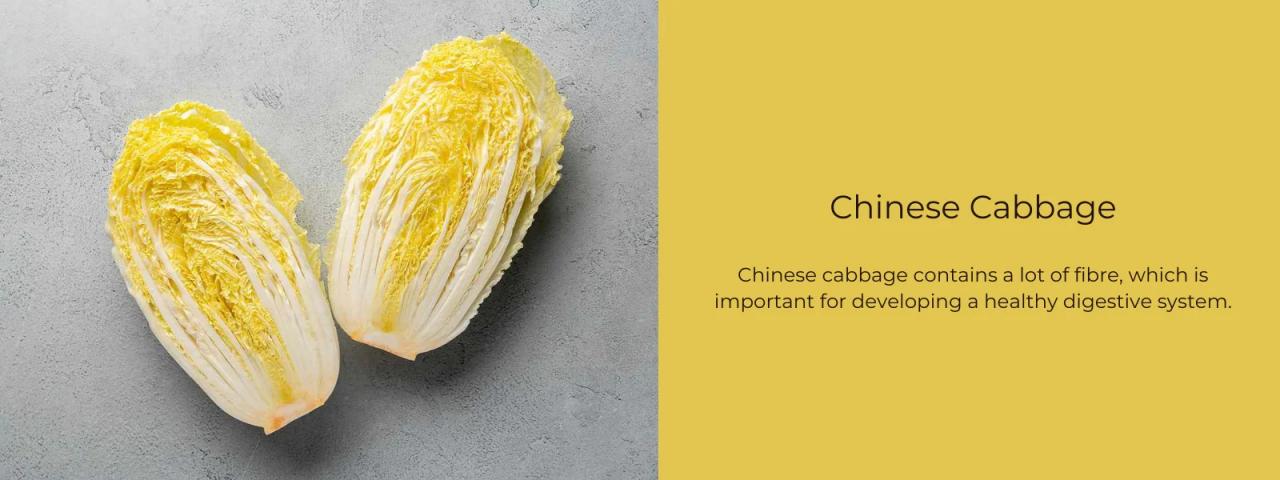Embark on a culinary and medicinal journey as we delve into the remarkable benefits of Chinese cabbage leaves, a nutritional powerhouse brimming with vitamins, minerals, and antioxidants. From enhancing immunity to aiding digestion, discover the multifaceted health benefits and culinary versatility of this leafy green.
Chinese cabbage leaves, also known as Napa cabbage, have been revered in traditional Chinese medicine for centuries, with scientific research now validating their purported healing properties.
Nutritional Benefits of Chinese Cabbage Leaves
Chinese cabbage leaves are a nutritional powerhouse, packed with a diverse array of vitamins, minerals, and antioxidants. They are particularly rich in vitamin C, vitamin K, folate, and potassium.
Vitamin C is a powerful antioxidant that helps protect cells from damage caused by free radicals. Vitamin K is essential for blood clotting and bone health. Folate is important for cell growth and division, and potassium helps regulate blood pressure and fluid balance.
Culinary Uses, Benefits of chinese cabbage leaves
Chinese cabbage leaves are versatile and can be used in a variety of culinary applications. They can be eaten raw in salads, stir-fried, added to soups, and used as a wrapping for dumplings and other dishes.
Chinese cabbage leaves have a mild, slightly peppery flavor that complements a wide range of cuisines. They can be used in both Asian and Western dishes.
Medicinal Properties
Chinese cabbage leaves have been used in traditional Chinese medicine for centuries to treat a variety of ailments, including indigestion, constipation, and ulcers.
Some studies have shown that Chinese cabbage leaves may have anti-inflammatory and antibacterial properties. They may also help lower cholesterol levels and improve blood sugar control.
Various plant leaves possess therapeutic properties, including makahiya leaves, which exhibit anti-inflammatory and analgesic effects. Similarly, the benefits of eating neem leaves during pregnancy extend to reducing nausea and boosting immunity. Furthermore, guava leaves offer antioxidant and anti-inflammatory properties, while sambong leaves are renowned for their medicinal benefits , including their ability to treat kidney stones and urinary tract infections.
Cultivation and Storage

Chinese cabbage is a cool-weather crop that can be grown in most parts of the world. It prefers well-drained soil and full sun to partial shade.
Chinese cabbage leaves can be harvested when they are young and tender, or when they are mature and have a more developed flavor. The leaves can be stored in the refrigerator for up to a week.
Ultimate Conclusion
Incorporating Chinese cabbage leaves into your diet not only elevates your culinary experiences but also nourishes your body from within. Their versatility extends from salads to soups, stir-fries, and beyond, making them a welcome addition to any cuisine. Embrace the health-promoting benefits of Chinese cabbage leaves and unlock a world of culinary and medicinal wonders.
Detailed FAQs: Benefits Of Chinese Cabbage Leaves
Is Chinese cabbage the same as Napa cabbage?
Yes, Chinese cabbage and Napa cabbage are the same vegetable.
What are the health benefits of eating Chinese cabbage leaves?
Chinese cabbage leaves are rich in vitamins, minerals, and antioxidants, which contribute to a range of health benefits, including improved immunity, reduced inflammation, and better digestion.
Can Chinese cabbage leaves be eaten raw?
The medicinal benefits of various leaves have been recognized for centuries. Makahiya leaves , for instance, are rich in antioxidants and anti-inflammatory compounds, making them effective in treating a range of ailments. Similarly, neem leaves are known for their antibacterial and antiviral properties, making them beneficial during pregnancy.
Additionally, guava leaves contain high levels of vitamin C and antioxidants, offering protection against various diseases. Furthermore, sambong leaves have been traditionally used to treat urinary tract infections and kidney stones, thanks to their diuretic and anti-inflammatory effects.
Yes, Chinese cabbage leaves can be eaten raw in salads, coleslaws, and other dishes.

